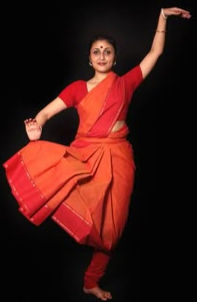THE ESSENTIAL BHARATHANATYAM ATTIRE : A BEGINNER’S CHECKLIST
- Vajra Balaji

- Jul 1
- 4 min read
For beginners, the sheer amount of specialized clothing and jewellery can seem a bit overwhelming. But don't worry! This checklist will break down the essentials, explaining what each component is and why it's important, so you can step onto the stage (or even just into your practice space) with confidence.
The Foundation: What You Wear
The Bharatanatyam Saree (or Practice Saree):

What it is: This is not your everyday saree! A traditional Bharatanatyam saree is specially stitched for dance, typically in vibrant colours. It features a pleated fan (or kucham) at the front that allows for maximum leg movement and a decorative pleated fan at the back. For beginners, your guru might recommend a simpler "practice saree" or even comfortable salwar kameez initially.
Why it's essential: It provides the freedom of movement required for the intricate footwork and wide leg stretches, while maintaining the traditional aesthetic.
Beginner Tip: Don't rush to buy an expensive performance saree. Start with comfortable practice wear or a basic practice saree as advised by your teacher.
Blouse (Ravekkai):
What it is: A fitted blouse worn underneath the saree, usually matching or complementing its color. It's designed to be snug but allow for arm movement.
Why it's essential: Provides comfort and support, and completes the traditional look.
Salwar Kameez (for practice):


What it is: A comfortable Indian outfit consisting of loose trousers (salwar), a tunic (kameez), and a scarf (dupatta).
Why it's essential for beginners: Many gurus recommend starting practice in comfortable salwar kameez before transitioning to a practice saree. It allows you to focus purely on technique without worrying about managing the drape of a saree.
The Ornaments: Adorning the Dancer
This is where the magic truly comes alive! Bharatanatyam jewelry is not just decorative; each piece has cultural and symbolic significance.
Nath (Nose Ring):

What it is: A delicate nose ring, often studded with pearls or stones. It can be a simple stud or a more elaborate ring.
Why it's essential: A traditional element of Indian classical dance and bridal attire, adding to the dancer's grace.
Maatal (Earrings with Chain):

What it is: Elaborate earrings, usually multi-tiered, with a chain that goes over the ear and hooks into the hair.
Why it's essential: Frames the face and enhances the expressiveness of the head movements (shirobhedas).
Necklaces (Short and Long):


What it is: Typically, two types are worn: a choker-style necklace (addam or choker) and a longer necklace (haar or muthu malai). Both are usually intricate and feature traditional motifs.
Why it's essential: Adorn the neck and chest, drawing attention to the subtle movements of the torso and angika abhinaya (body language).
Vanki (Armlets):

What it is: Ornate armlets worn on the upper arms. They can be flexible or rigid.
Why it's essential: Highlight the graceful movements of the arms (hastabhinaya) and shoulders.
5. Oddiyanam (Waist Belt):

What it is: A sturdy, often elaborate, metal belt worn around the waist.
Why it's essential: Accentuates the waistline, defines the dancer's posture, and helps keep the saree in place during vigorous movements.
Bangles (Valayal):

What it is: A set of bangles, often gold or gold-plated, worn on both wrists.
Why it's essential: The gentle jingle of the bangles adds an auditory element, complementing the rhythm of the footwork, and enhances arm movements.
Salangai (Anklets/Ghungroos):

What it is: The most iconic and arguably the most crucial accessory! These are strands of small brass bells, strung together and tied around the ankles.
Why it's essential: They produce the distinct rhythmic sound that is integral to Bharatanatyam, marking the intricate footwork (adavus and jati). You'll typically start with lighter ones and gradually move to heavier sets as your technique strengthens.
Beginner Tip: Your guru will guide you on when and what type of salangai to purchase.
The Finishing Touches: Hair and Makeup
Hair Braids and Accessories:


What it is: Hair is typically tied into a long, neat braid, often extended with artificial hair (jata) for length and adorned with traditional ornaments like the rakodi (circular headpiece) and chandran and suryan (moon and sun ornaments). Flowers (often jasmine) are also woven into the braid.
Why it's essential: Creates a neat, elegant look that doesn't obstruct movement and adds to the overall traditional aesthetic.
Makeup:

What it is: Performance makeup for Bharatanatyam is theatrical, designed to make expressions visible from a distance. This includes defined eyes (kajal/eyeliner), bold eyebrows, and often bright lipstick.
Why it's essential: Enhances facial expressions (mukhabhinaya) and helps convey emotions to the audience. For practice, minimal or no makeup is fine.
Kumkum/Bindi:
What it is: A traditional red dot or design applied on the forehead.
Why it's essential: A cultural and aesthetic marker, completing the traditional look.
A Word of Advice for Beginners:
Don't feel pressured to buy everything at once! Your guru will guide you on what you need and when.
Prioritize comfort for practice. Focus on learning the basics before investing in full performance attire.
Quality over quantity. When you do invest, choose durable pieces that will last.
Understand the significance. Each piece of attire tells a story and contributes to the richness of the Bharatanatyam experience.
Embrace this beautiful journey, and enjoy adorning yourself in the elegance of Bharatanatyam attire as you continue to learn and grow in this divine art form!





Comments